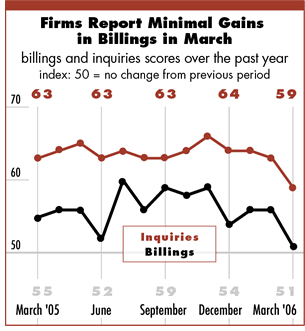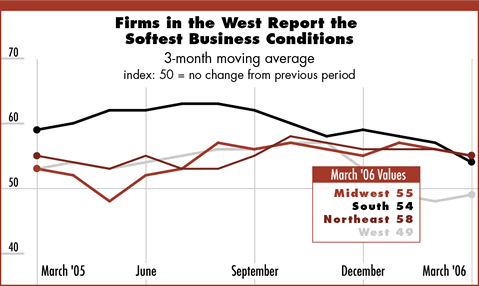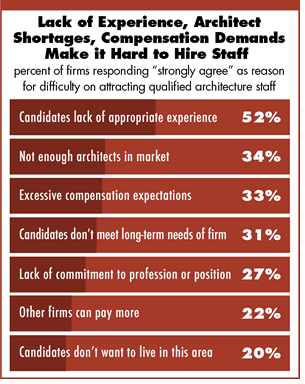

4/2006
Perceived shortage in architects makes attracting new staff a concern


by Kermit Baker, PhD,
Hon. AIA
Chief Economist
 Billings at U.S. architecture firms leveled off in March,
with the AIA Architectural Billings Index registering just 50.5 for the
month. Any score above 50 indicates an increase in billings from the
previous month, so March billings after seasonal adjustment were just
slightly in excess of February levels. Inquiries for new projects continued
to grow, pointing to increasing project activity in the months ahead.
However, the 59.4 score for the inquiries index is the lowest since May
of 2004, so incoming work should be monitored to see if it is beginning
to slow.
Billings at U.S. architecture firms leveled off in March,
with the AIA Architectural Billings Index registering just 50.5 for the
month. Any score above 50 indicates an increase in billings from the
previous month, so March billings after seasonal adjustment were just
slightly in excess of February levels. Inquiries for new projects continued
to grow, pointing to increasing project activity in the months ahead.
However, the 59.4 score for the inquiries index is the lowest since May
of 2004, so incoming work should be monitored to see if it is beginning
to slow.
Regionally, business conditions remain solid for firms in the Northeast, Midwest, and South. Firms in the West, however, have reported declines in each of the first three months of the year. By construction sector, residential architects are reporting continued solid levels of activity, and firms principally serving the commercial/industrial sector are reporting a growth in billings in recent months. Institutional firms, however, reported a decline in March, coming on the heels of a decline in February.
Jobs indicate healthy growth
The broader economy continues to show signs of healthy growth. Over 200,000
net new jobs were created in March, bringing the total to almost 600,000
for the first quarter of the year. That puts the economy on pace to
create well over 2 million net new jobs this year, in excess of the
pace of job growth last year.

Job growth in the construction sector slowed in March. However, in February, total construction put in place totaled close to $1.2 trillion when seasonally adjusted and annualized, 8 percent above year-ago levels. The nonresidential sectors have done particularly well recently. The retail and other commercial construction, education, and health-care sectors all increased at a double-digit rate in February compared to year-ago levels, and office construction was not far behind, growing by 9 percent.
The major threat to the economic outlook continues to be inflation, particularly in oil prices. Overall inflation for consumer goods and services is running close to 4 percent annually, while inflation in producer prices is running about 5 percent. Price increases for several construction commodities are a key reason for the increases in producer prices. Inflation hasn’t been at this level since the early 1990s. Consumers, however, seem to have adjusted to rising rates of inflation. Consumer sentiment rose with the early April reading, and stands well above the levels of last fall when the oil price spikes first appeared.
 Experienced staff at a premium
Experienced staff at a premium
As nonresidential activity continues to improve, architecture firms report
difficulties in finding architecture staff. Earlier this year, architecture
firms reported that attracting new staff was at the top of their list
for business-related concerns for the year.
This month, we asked firms for the reasons that they were having difficulties in attracting new staff. The most frequent response was that many applicants don’t have appropriate experience for the openings at their firm. A general shortage of architects in the market was the second most common response, followed by the sense that many applicants are looking for more compensation than the firm can afford. Larger firms were likely to mention a shortage of architects in the market as the key reason for difficulties in attracting new qualified staff. Smaller firms were more likely to mention that other firms can afford to pay more for qualified applicants.
Regionally, firms in the Northeast were more likely to mention that applicants are looking for more compensation than the firm can afford than were firms in other regions. Firms in the Midwest were more likely to mention that applicants don’t have the appropriate experience for openings at the firm, and that potential applicants don’t want to live in the area. Firms in the South were more likely to mention that applicants don’t have the skills and aptitude to meet the longer-term needs of the firm. Firms in the West were more likely to mention that there are not enough architects in the market at present.
Copyright 2006 The American Institute of Architects.
All rights reserved. Home Page ![]()
![]()
This month,
Work-on-the-Boards participants are saying:
• Definite slowdown in residential construction. I think folks are having
problems heating the McMansions.
• The employee pool in our area is small and underqualified. As the workload
increases, we need to find another way to find staff.
• After being slow the last 3-4 years, we are suddenly inundated with
institutional, light commercial, and residential work.
• We are seeing an increase in volume after a slower January
and February
![]()